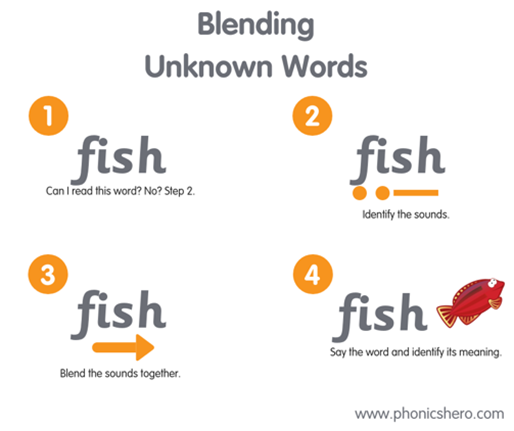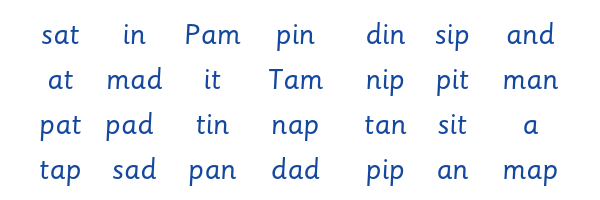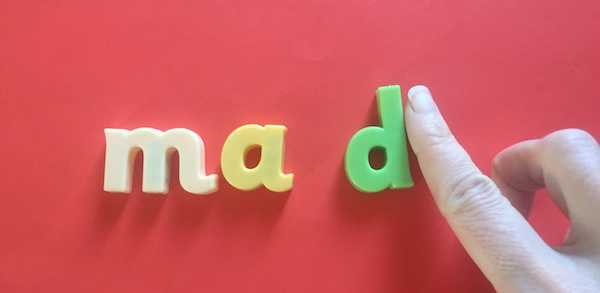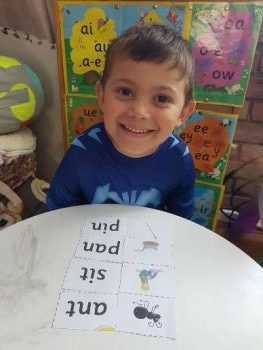Books to Read When Teaching Blending of S
Helping the Blending Penny Driblet!

I've pushed the learning of alphabetic character sounds all yr, but the penny is not dropping on blending."
Blending has been a challenge and the kids are getting frustrated with information technology. Nosotros've decided to go back to the letter sounds."
When I hear things like this my answer is e'er "Blend! Alloy! Blend!"
I say this because I don't believe nosotros do enough of information technology. Is information technology because we feel it is also difficult for young children to achieve? Or is it just easier for us to allow children to merely over-learn the letter-sound correspondences in isolation?
Either way, information technology can't exist overlooked; blending is a crucial skill that every child needs to start reading unknown words. It's so critical that in England, the Year 1 Phonics Cheque gives children nonsense words to assess if the child tin (or probably more accurately – check the teacher has taught the kid) to blend. Australia is also looking at introducing the Phonics Cheque, but and then far, South Australia is the only state that has mandated this assessment. More on the Phonics Check here.
What is Blending?
Blending is the skill that helps us read, especially when confronted with unfamiliar words. For young children, most words are unfamiliar and they volition need to blend many of the words they encounter. It involves pushing together the sounds of the letters in the discussion in order to create the whole discussion. For instance, a child trying to read the word 'fish', volition isolate each of the letter sounds. When these 3 sounds are said in sequence, the word 'fish' is spoken.
 How a child should tackle unknown words for reading.
How a child should tackle unknown words for reading. How Do Nosotros Teach Blending?
Blending is non a difficult skill to primary. It only requires Do and lots of it. It's disquisitional to introduce children to the phonemic awareness skills of oral blending at an early on historic period. Modelling how to orally blend to create a spoken give-and-take and how to break a word autonomously is how to start a kid'due south blending and segmenting journey. Once children can blend at an oral level, the blending of words in print becomes a lot easier. There is a great blog post on oral blending and segmenting here.
Below is a kid who began his reading journey at 3.5 years of age. While it is non fluent, it is a outset. Proceed watching the footage as we meet the same child half-dozen months later on.

The difference in but 6 months!
The key is to E'er incorporate blending activities when teaching alphabetic character sounds. Exercise non wait until all the sounds of the alphabet are washed. Subsequently a handful of sounds have been learned, words can be blended. Accept the following group of letter of the alphabet sounds:

After but these 8 letter sounds are taught, nosotros can brainstorm pedagogy children to blend words such as sat, pan, tap, mad.
 28 opportunities for practise with only viii sounds!
28 opportunities for practise with only viii sounds! Using No-Prep Phonics Lessons to Teach Blending
Having to provide students with a bank of decodable words and sentences, which are also differentiated, mid-lesson tin can leave you flustered. Phonics Hero's click-and-go Phonics Lessons are designed to ease the workload of planning a great phonics lesson. It contains over 3,500 decodable words and over two,000 sentences – all with sound buttons, blending support and pictures to check agreement. Check out this whistle-end bout of a blending lesson:
Y'all can starting time a 30-day trial of the no-prep Phonics Lessons with a Teacher Business relationship.
Top 5 Tips to Help the Blending Penny Drop
one. Immerse the children in oral blending as early on as you can.

This tin can be done through games such as:
- I Spy. E.g. "I tin spy with my little center a h-a-t."
- Lesson breakers – while giving an instruction break i of the words into isolated sounds: "Can you delight put this in the b-a-g?" or "Put the c-u-p on the table." My children loved hearing me do this. What I was doing was modelling the spelling strategy while they were practising blending.
- Oral bingo – my children developed blending because they became proficient at oral blending. Download my oral bingo game here. I also like to employ this with older students who are having difficulty with the blending strategy.
ii. Take hold of some magnetic letters and physically show the messages crashing into each other as you alloy the word. This visual representation of blending tin can often be that 'lightbulb moment' for a child where blending starts to brand sense.
 Physically testify blending with the magnetic letters being pushed together.
Physically testify blending with the magnetic letters being pushed together. 3. Always accept pictures gear up for the words the children are blending. These pictures are not there to encourage guessing but as a confirmation later blending. This volition help them blend hands considering they tin see the spoken word that has been formed through the pictures. Eventually, blending becomes automatic and pictures volition not exist needed. Our reading worksheets are a keen tool to assist you practise with pictures (teachers access them here or parents can purchase them hither).
 A child matching the words and the pictures.
A child matching the words and the pictures. 4. If children are not saying the correct word when blending isolated sounds, effort these other blending techniques:
- Isolated blending – say the first audio the loudest and then become softer as you lot get to the end of the give-and-take. Children exercise tend to outset blending with the loudest sound they heard. And then brand certain your showtime audio is the loudest.
- Final blending – blend the outset two letter sounds together and so snap it with the final letter sound. For example:

This helps with children who are not post-obit through with their blending or with those who simply cannot hear the spoken give-and-take existence formed. - Successive blending – stretch the word in a continuous menstruum of sounds. For case:


In this curt video I demonstrate these three blending techniques:

five. Blend! Blend! Persevere! Blend! Blend! These skills of blending and segmenting do not develop automatically. They must be modelled and explicitly taught. Don't give up and your students will reap the rewards of your perseverance.
Older Children who are Struggling with Blending
It tin feel like a real challenge for a Year Three teacher who has students who can't blend 'cat' and also those who are reading chapter books! For these older students, information technology'southward often the same issues the get-go reader is having.
In this instance, firstly, don't soldier on with learning more than complicated sounds (ii-alphabetic character digraphs or three-alphabetic character trigraphs), you will exist overloading a child's working retention. Go back and start with the basic unmarried letter sounds.
Next, cheque their phonological and phonemic sensation skills. These are the underlying skills that a kid needs to make the 'blending penny drop'. Read this web log post on cess.
Go back to the basics. You might demand to cease blending with messages and become back to oral blending. Information technology may feel similar you are going backwards if the child is much older just this skill needs to be firmly embedded. Ask yourself, are yous teaching where they are at, or where they should be?
For 99% of children the blending penny will drib – it just needs lots of modelling, repetition, practice and a steadfast conclusion that every kid volition acquire to read!
Author: Santina DiMauro
Santina is a teacher and phonics consultant. She has taught in schools for over 30 years and has trained teachers across Australia and Asia for 20 years in the area of literacy, in particular, synthetic phonics. If you are interested in Santina'southward help as a literacy trainer for your school, drop the team an e-mail at info@phonicshero.com.
Source: https://phonicshero.com/blending/
0 Response to "Books to Read When Teaching Blending of S"
ارسال یک نظر